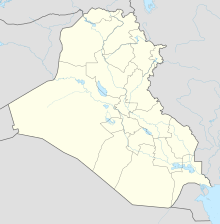
Back معركة القادسية Arabic Qadisiyyə döyüşü Azerbaijani قادسیه دؤیوشو AZB Битка при Кадисия Bulgarian কাদিসিয়ার যুদ্ধ Bengali/Bangla Bitka kod El-Kadisije BS Batalla d'al-Qadisiyya Catalan Schlacht von al-Qādisīya German Batalla de al-Qadisiyya Spanish نبرد قادسیه Persian
This article includes a list of general references, but it lacks sufficient corresponding inline citations. (January 2024) |
| Battle of al-Qādisiyyah | |||||||||
|---|---|---|---|---|---|---|---|---|---|
| Part of the Muslim conquest of Persia | |||||||||
 Depiction of the battle from a manuscript of the Persian epic Shahnameh | |||||||||
| |||||||||
| Belligerents | |||||||||
| Rashidun Caliphate | Sasanian Empire | ||||||||
| Commanders and leaders | |||||||||
|
Sa`d ibn Abī Waqqās Khalid bin Arfatah[1] Al-Muthanna ibn Haritha Al-Qa'qa' ibn Amr al-Tamimi Asim ibn 'Amr al-Tamimi Abdullah ibn al-Mu'tam Shurahbil ibn Simt Zuhra ibn al-Hawiyya Jarir ibn Abd Allah al-Bajali Tulayha Amru bin Ma'adi Yakrib |
Rostam Farrokhzād † Bahman Jadhuyih † Hormuzan Jalinus †[2] Shahriyar bin Kanara †[3] Mihran Razi Piruz Khosrow Kanadbak Grigor II Novirak †[4] Tiruyih Mushegh III †[4] Javanshir Nakhiragan | ||||||||
| Units involved | |||||||||
| Rashidun army | Sasanian army | ||||||||
| Strength | |||||||||
| 30,000[5] | Unknown[a] | ||||||||
| Casualties and losses | |||||||||
| Heavy[7] | Heavy[7] | ||||||||
Location within modern-day Iraq | |||||||||
The Battle of al-Qadisiyyah[b] (Arabic: مَعْرَكَة ٱلْقَادِسِيَّة, romanized: Maʿrakah al-Qādisīyah; Persian: نبرد قادسیه, romanized: Nabard-e Qâdisiyeh) was an armed conflict which took place in 636 CE between the Rashidun Caliphate and the Sasanian Empire. It occurred during the early Muslim conquests and marked a decisive victory for the Rashidun army during the Muslim conquest of Persia.
The Rashidun offensive at Qadisiyyah is believed to have taken place in November of 636. The leader of the Sasanian army at the time, Rostam Farrokhzad, died in uncertain circumstances during the battle. The subsequent collapse of the Sasanian army in the region led to a decisive Arab victory over Sasanian power, and the incorporation of territory that comprises modern-day Iraq into the Rashidun Caliphate.[8]
Arab successes at Qadisiyyah were key to the later conquest of the Sasanian province of Asoristan, and were followed by major engagements at Jalula and Nahavand. The battle allegedly saw the establishment of an alliance between the Sasanian Empire and the Byzantine Empire, with claims that the Byzantine emperor Heraclius married off his granddaughter Manyanh to the Sasanian king Yazdegerd III to symbolize the alliance.[citation needed]
Scholars from Durham University and the University of Al-Qadisiyah identified the likely location of the Battle of al-Qadisiyyah in 2024.[9][10]
- ^ Crawford 2013, p. 138.
- ^ Pourshariati 2011, p. 157.
- ^ Pourshariati 2011, p. 232-233, 269.
- ^ a b Pourshariati 2011, p. 232-233.
- ^ Dupuy & Dupuy 1996, p. 249.
- ^ Daryaee 2014, p. 37.
- ^ a b Morony 1986.
- ^ Lewental 2014.
- ^ "Archaeologists identify centuries-old battle site in Iraq using declassified spy satellite images". CNN.
- ^ "Declassified US Spy Satellite Images Reveal Ancient Battle Site". Newsweek.
Cite error: There are <ref group=lower-alpha> tags or {{efn}} templates on this page, but the references will not show without a {{reflist|group=lower-alpha}} template or {{notelist}} template (see the help page).
